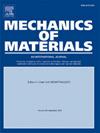Stimuli–responsive programmable mechanics of bi-level architected nonlinear mechanical metamaterials
IF 3.4
3区 材料科学
Q2 MATERIALS SCIENCE, MULTIDISCIPLINARY
引用次数: 0
Abstract
Mechanical metamaterials which are often conceptualized as a periodic network of beams have been receiving significant attention over the last decade, wherein the major focus remains confined to the design of micro-structural configurations to achieve application-specific multi-functional characteristics in a passive framework. It is often not possible to actively modulate the metamaterial properties post-manufacturing, critically limiting the applications for a range of advanced intelligent structural systems. To achieve physical properties beyond conventional saturation limits attainable only through unit cell architectures, we propose to shift the design paradigm towards more innovative bi-level modulation concepts involving the coupled design space of unit cell geometries, architected beam-like members and their stimuli–responsive deformation physics. On the premise of revolutionary advancements in additive manufacturing technologies, we introduce hard magnetic soft (HMS) material architectures in the beam networks following physics-informed insights of the stress resultants. Through this framework, it is possible to achieve real-time on-demand control and modulation of fundamental mechanical properties like elastic moduli and Poisson’s ratios based on a contactless far-field stimuli source. A generic semi-analytical computational framework involving the large-deformation geometric non-linearity and material non-linearity under magneto-mechanical coupling is developed for the effective elastic properties of HMS material based bi-level architected lattices under normal or shear modes of mechanical far-field stresses, wherein we demonstrate that the constitutive behaviour can be programmed actively in an extreme-wide band based on applied magnetic field. Under certain combinations of the externally applied mechanical stress and magnetic field depending on the residual magnetic flux density, it is possible to achieve negative stiffness and negative Poisson’s ratio with different degrees of auxecity, even for the non-auxetic unit cell configurations. The results further reveal that a single metamaterial could behave like extremely stiff metals to very soft polymers through contactless on-demand modulation, leading to a wide range of applicability in statics, stability, dynamics and control of advanced mechanical, aerospace, robotics and biomedical systems at different length scales.
双层结构非线性机械超材料的刺激响应可编程力学
机械超材料通常被概念化为周期性的梁网络,在过去十年中受到了极大的关注,其中主要焦点仍然局限于微结构配置的设计,以在被动框架中实现特定应用的多功能特性。通常不可能在制造后主动调节超材料的特性,严重限制了一系列先进智能结构系统的应用。为了实现超越常规饱和限制的物理特性,我们建议将设计范式转向更创新的双电平调制概念,涉及单元几何形状、结构梁状构件及其刺激响应变形物理的耦合设计空间。在增材制造技术取得革命性进步的前提下,我们根据对应力结果的物理了解,在光束网络中引入了硬磁软(HMS)材料架构。通过该框架,可以实现基于非接触远场刺激源的弹性模量和泊松比等基本机械性能的实时按需控制和调制。针对基于HMS材料的双层结构晶格在机械远场应力的正态或剪切模式下的有效弹性特性,开发了一个涉及大变形几何非线性和材料非线性的磁-力耦合的通用半解析计算框架,其中我们证明了基于外加磁场的本构行为可以在极宽的频带内主动编程。根据残余磁通密度,在一定的外部机械应力和磁场组合作用下,即使对于非auxxi的单元格结构,也有可能实现不同程度的负刚度和负泊松比。研究结果进一步表明,通过非接触式按需调制,单一超材料可以表现得像极其坚硬的金属到非常柔软的聚合物,从而在不同长度尺度的先进机械、航空航天、机器人和生物医学系统的静力学、稳定性、动力学和控制方面具有广泛的适用性。
本文章由计算机程序翻译,如有差异,请以英文原文为准。
求助全文
约1分钟内获得全文
求助全文
来源期刊

Mechanics of Materials
工程技术-材料科学:综合
CiteScore
7.60
自引率
5.10%
发文量
243
审稿时长
46 days
期刊介绍:
Mechanics of Materials is a forum for original scientific research on the flow, fracture, and general constitutive behavior of geophysical, geotechnical and technological materials, with balanced coverage of advanced technological and natural materials, with balanced coverage of theoretical, experimental, and field investigations. Of special concern are macroscopic predictions based on microscopic models, identification of microscopic structures from limited overall macroscopic data, experimental and field results that lead to fundamental understanding of the behavior of materials, and coordinated experimental and analytical investigations that culminate in theories with predictive quality.
 求助内容:
求助内容: 应助结果提醒方式:
应助结果提醒方式:


